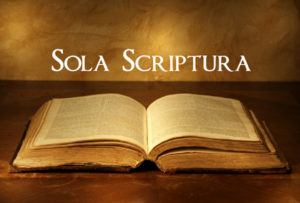 In our post-modern, post-Christian era we find ourselves arguing over the meaning of truth. For the post-modernist, truth, and absolute truth, is unknowable, unattainable and an exercise in arrogance. “You have your truth and I have mine.” As a result of this kind of lunacy, we find the authority of the Bible, as never before, under attack. This attack is focused, as you would expect, on the doctrines of inerrancy and infallibility. A denial of the “correspondence view of truth” as being played out at Moody Bible Institute is a prime example.
In our post-modern, post-Christian era we find ourselves arguing over the meaning of truth. For the post-modernist, truth, and absolute truth, is unknowable, unattainable and an exercise in arrogance. “You have your truth and I have mine.” As a result of this kind of lunacy, we find the authority of the Bible, as never before, under attack. This attack is focused, as you would expect, on the doctrines of inerrancy and infallibility. A denial of the “correspondence view of truth” as being played out at Moody Bible Institute is a prime example.
When we speak of the “correspondence view of truth,” concerning the Bible we mean; that if something is true, then it describes something real that actually happened or actually existed. The post-modernist and those in Evangelicalism infected with this virus reject the “correspondence view of truth,” holding that something can be true even if it didn’t happen, but merely served a function within a specific parable or legend to bring spiritual truth. As an example, the creation story can be historically inaccurate and yet serve to teach some sort of spiritual truth. A world-wide flood is viewed as a local flood, again with a spiritual message in the midst of a historical lie. The Israelites upon fleeing Pharoh didn’t cross the Red Sea on dry ground, but rather the Reed Sea during a time when the waters were low. I suppose the real miracle was how quickly the waters returned and drowned the whole of the Egyptian Army that was in pursuit. Just exactly what would be the spiritual truth taught here? Or that the magi of the book of Matthew that visited Jesus were a legend added to enhance the story of the birth of Christ. Again we are left looking for the spiritual truth being taught through a lie.
This becomes the real problem. We then have a God speaking through the written Word with ambiguity, with the use of non-historical events and stories, that leaves us hostage to those who claim the authority to be the “seers” who can walk the “laity” through the nuances of spiritual speak. Once we deny the infallibility and the inerrancy of the Scriptures to ANY degree, ANY degree, the obvious (Perspicuity, clarity) spiritual message is lost and we are left with the errant wisdom of men and the Gospel and centrality of Christ in the Old and New Testaments are in real jeopardy if not lost.
It also cannot be said that the Chicago Statement on Inerrancy didn’t address “the correspondence view” simply because the terms are absent from the statement as some have claimed. That kind of argument is similar to the United Pentecostals’ denial of the Trinity simply because the word “Trinity” is not found in the Bible. The Chicago Statement on Inerrancy through all 19 articles, emphatically declares the correspondence view of truth.
So, let’s be clear, a denial of the correspondence view of truth regarding the Scriptures is a denial of infallibility and inerrancy and to call our Lord’s view of verbal plenary inspiration a lie.
Matthew 5:18 (ESV) 18 For truly, I say to you, until heaven and earth pass away, not an iota, not a dot, will pass from the Law until all is accomplished. (emphasis added)
-Michael Holtzinger
Helpful Resources:
Vital Issues in the Inerrancy Debate General Editor F. David Farnell
The Scripture Cannot Be Broken By John MacArthur
